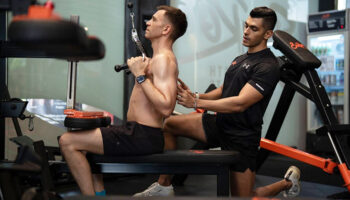Why hawker eating and fitness must coexist
In Singapore, eating at hawker centres is part of daily life. Cai png, yong tau foo, prata, nasi lemak, and ban mian are not just meals, they are cultural anchors. For many office workers and families, hawker food is affordable, accessible, and varied. Yet it often gets unfairly criticised as “unhealthy.”
The reality is that hawker meals can fit into a structured nutrition plan with proper guidance. A fitness trainer Singapore helps clients build “macro-aware” meals from common stalls, aligning protein, carbohydrates, and fats with training goals. Instead of forcing clients into expensive diets, trainers teach them to order smarter at the same places they already eat.
The macro basics trainers emphasise
Macronutrients are the building blocks of every meal. Trainers break them down in simple, practical terms.
-
Protein: builds and repairs muscle. Found in chicken, fish, tofu, eggs, tempeh, and lean beef.
-
Carbohydrates: provide energy. Rice, noodles, bread, oats, and fruit form the base.
-
Fats: support hormones and long-term fuel. Oils, nuts, coconut milk, and fatty cuts supply them.
-
Fibre: technically not a macro, but trainers include it to regulate digestion and satiety.
By teaching clients how to identify these in hawker meals, trainers transform ordinary plates into performance fuel.
Cai png (economic rice) customisation
Cai png stalls are a nutrition goldmine if ordered wisely. Trainers often recommend:
-
Base: half rice portion for moderate carbs, or swap for brown rice if available.
-
Protein: steamed chicken, tofu, egg, or fish instead of fried meats.
-
Vegetables: at least two servings of greens, stir-fried or steamed.
-
Sauce control: request “less gravy” to reduce hidden fats and sodium.
This creates a balanced macro split without overspending or overthinking.
Yong tau foo as a modular meal
Yong tau foo allows total flexibility. A fitness trainer Singapore might suggest:
-
Protein picks: fish balls, tau kwa, boiled egg, chicken slices.
-
Vegetables: broccoli, spinach, bean sprouts, bitter gourd.
-
Carbs: bee hoon or rice, but in smaller amounts if weight loss is a goal.
-
Soup base: clear broth instead of laksa or curry for fewer calories.
Clients quickly learn how to hit their macro targets by mixing and matching.
Noodle dishes and modifications
Not all noodle dishes are off-limits. Trainers simply adjust them.
-
Ban mian: keep vegetables and egg, add extra tofu, ask for less oil.
-
Mee siam: balance with protein on the side, such as boiled eggs.
-
Fishball noodles: choose soup version, add more greens, reduce noodles slightly.
The principle is balance, not elimination. Even comfort foods can be reshaped.
Breakfast classics made smarter
Local breakfasts are beloved, and trainers adapt them rather than remove them.
-
Kaya toast set: switch to wholemeal bread, keep soft-boiled eggs, balance with kopi kosong siu dai.
-
Prata: limit to one piece, pair with dhal or egg prata for protein, avoid heavy curry toppings.
-
Chwee kueh: reduce portion, combine with protein-rich side like soy milk or eggs.
This maintains culture while meeting fitness needs.
Trainers and portion education
One of the biggest challenges is portion control. Hawker portions can be large or small depending on the stall. Trainers teach clients to visualise macros.
-
Protein: size of your palm
-
Carbs: size of your fist
-
Fats: size of your thumb
-
Vegetables: half the plate
This visual method works in any hawker stall without needing scales or apps.
Hydration and drink choices
Sugary drinks are a hidden calorie trap. Trainers coach clients to modify orders.
-
Kopi or teh: request less sugar, or kosong siu dai
-
Iced drinks: avoid syrup, choose plain iced water or unsweetened tea
-
Fruit juices: ask for no added sugar, or opt for whole fruits instead
These simple tweaks reduce calorie load while preserving enjoyment.
Case studies of hawker macro success
-
Office executive, 29: Ate cai png daily, but trainer taught her to swap fried items for steamed fish and double vegetables. Result: 4 kg fat loss in 12 weeks.
-
Taxi driver, 47: Regular prata breakfast replaced with egg prata and unsweetened kopi. Energy improved, cholesterol levels dropped.
-
Student, 21: Yong tau foo customised with tofu, eggs, and vegetables while keeping bee hoon. Muscle mass increased during training cycle.
These cases show real people can thrive without abandoning hawker food.
Long-term sustainability
The goal is not to diet but to build habits that last. A fitness trainer Singapore ensures clients understand principles, not just prescriptions. Once clients learn to scan a stall and pick balanced options, they gain independence. They can eat with colleagues, family, or friends without stress.
At the same time, trainers may recommend occasional structured gym sessions in places such as TFX for more controlled training environments. Pairing smarter eating with structured exercise produces sustainable results.
FAQs about eating with hawker macros and a fitness trainer Singapore
Q. Can I still eat fried foods if I am training?
A. Yes, in moderation. Trainers usually suggest balancing with lean protein and vegetables in the same meal to control overall nutrition.
Q. How do I handle late-night suppers at hawker centres?
A. Pick lighter protein-rich meals like fish soup or yong tau foo, and avoid heavy carb or fried options at night.
Q. Do I need to track every calorie?
A. Not necessarily. Trainers often teach portion visuals and macro awareness, which is easier to follow long term than strict calorie counting.
Q. Are vegetarian hawker meals suitable for muscle building?
A. Yes. Options like chapati with dhal, vegetarian bee hoon with extra tofu, or cai png with tempeh can provide sufficient protein when balanced properly.
Q. Is it possible to prepare for races or strength goals while eating mostly at hawker centres?
A. Absolutely. Trainers customise food strategies around training needs, ensuring you get enough protein, carbs, and hydration from hawker options.





